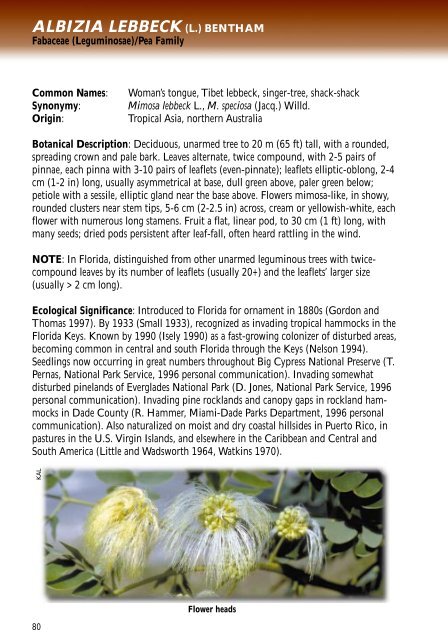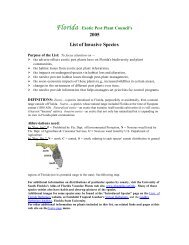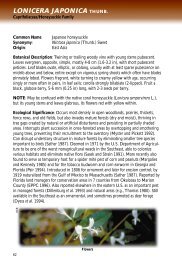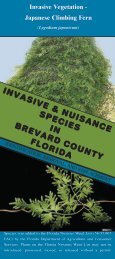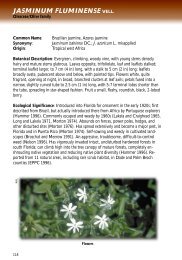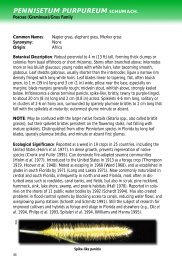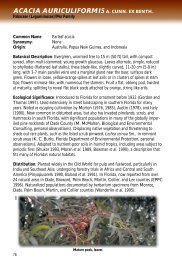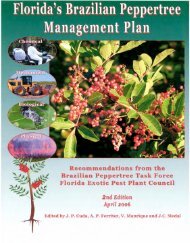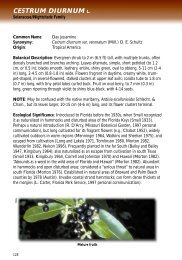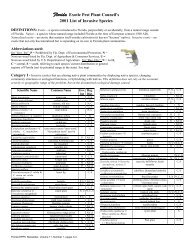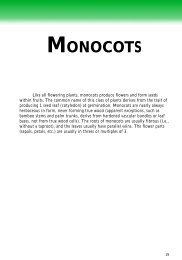DICOTS - Florida Exotic Pest Plant Council
DICOTS - Florida Exotic Pest Plant Council
DICOTS - Florida Exotic Pest Plant Council
You also want an ePaper? Increase the reach of your titles
YUMPU automatically turns print PDFs into web optimized ePapers that Google loves.
Albizia lebbeck (L.) Bentham<br />
Fabaceae (Leguminosae)/Pea Family<br />
Common Names: Woman’s tongue, Tibet lebbeck, singer-tree, shack-shack<br />
Synonymy: Mimosa lebbeck L., M. speciosa (Jacq.) Willd.<br />
Origin: Tropical Asia, northern Australia<br />
Botanical Description: Deciduous, unarmed tree to 20 m (65 ft) tall, with a rounded,<br />
spreading crown and pale bark. Leaves alternate, twice compound, with 2-5 pairs of<br />
pinnae, each pinna with 3-10 pairs of leaflets (even-pinnate); leaflets elliptic-oblong, 2-4<br />
cm (1-2 in) long, usually asymmetrical at base, dull green above, paler green below;<br />
petiole with a sessile, elliptic gland near the base above. Flowers mimosa-like, in showy,<br />
rounded clusters near stem tips, 5-6 cm (2-2.5 in) across, cream or yellowish-white, each<br />
flower with numerous long stamens. Fruit a flat, linear pod, to 30 cm (1 ft) long, with<br />
many seeds; dried pods persistent after leaf-fall, often heard rattling in the wind.<br />
NOTE: In <strong>Florida</strong>, distinguished from other unarmed leguminous trees with twicecompound<br />
leaves by its number of leaflets (usually 20+) and the leaflets’ larger size<br />
(usually > 2 cm long).<br />
Ecological Significance: Introduced to <strong>Florida</strong> for ornament in 1880s (Gordon and<br />
Thomas 1997). By 1933 (Small 1933), recognized as invading tropical hammocks in the<br />
<strong>Florida</strong> Keys. Known by 1990 (Isely 1990) as a fast-growing colonizer of disturbed areas,<br />
becoming common in central and south <strong>Florida</strong> through the Keys (Nelson 1994).<br />
Seedlings now occurring in great numbers throughout Big Cypress National Preserve (T.<br />
Pernas, National Park Service, 1996 personal communication). Invading somewhat<br />
disturbed pinelands of Everglades National Park (D. Jones, National Park Service, 1996<br />
personal communication). Invading pine rocklands and canopy gaps in rockland hammocks<br />
in Dade County (R. Hammer, Miami-Dade Parks Department, 1996 personal<br />
communication). Also naturalized on moist and dry coastal hillsides in Puerto Rico, in<br />
pastures in the U.S. Virgin Islands, and elsewhere in the Caribbean and Central and<br />
South America (Little and Wadsworth 1964, Watkins 1970).<br />
KAL<br />
80<br />
Flower heads


